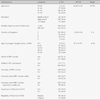Abstract
Purpose
This study was done to examine mothers' acceptance and its influencing factors in daughters' human papillomavirus (HPV) vaccination to prevent cervical cancer.
Methods
From July 20 to August 31, 2010, 220 mothers of unmarried daughters responded to self-administered questionnaires about their acceptance of HPV vaccination for their daughters and the optimal age for HPV vaccination. Descriptive statistics, univariate logistic and multiple logistic regression were used for data analysis with SPSS/WIN 12.0.
Results
Mothers indicating their willingness to pay for their daughters to receive HPV vaccination accounted for 61.8%, and willingness with health insurance coverage, 84.5%. Mean optimal age for HPV vaccination was 19.78±3.96) years. With self-payment the factor influencing mothers willingness was necessity of HPV vaccination (OR=30.45, 95% CI=10.33~89.15). With health insurance coverage, income (OR=3.02, 95% CI: 1.19~7.62), necessity of HPV vaccination (OR=15.05, 95% CI=4.15~54.64), concern about HPV vaccine safety (OR=2.99, 95% CI=1.15~7.76), and experience of Pap test (OR=3.16, 95% CI=1.24~8.05) were factors influencing mothers willingness. Other influencing factors were optimal age for HPV vaccination, knowing about HPV (OR=7.66, 95% CI=2.19~26.82), and age of youngest daughter (OR=3.95, 95% CI=1.34~11.68).
Figures and Tables
References
1. Recommendations for human papilloma virus (HPV) vaccine use to prevent cervical cancer and pre-cancers. American Cancer Society. 2010. 04. 21. Retrieved April 22, 2011. from http://www.cancer.org/Cancer/CancerCauses/OtherCarcinogens/InfectiousAgents/HPV/acs-recommendations-for-hpv-vaccine-use.
2. Bartolini R.M., Drake J.K., Creed-Kanashiro H.M., Diaz-Otoya M.M., Mosqueira-Lovon N.R., Penny M.E., et al. Formative research to shape HPV vaccine introduction strategies in Peru. Salud Publica de Mexico. 2010. 52:226–233.
3. Brewer N.T., Fazekas K.I. Predictors of HPV vaccine acceptability: A theory-informed, systematic review. Preventive Medicine. 2007. doi: 10.1016/j.ypmed.2007.05.013.
4. Choi K.A., Kim J.H., Lee K.S., Oh J.K., Liu S.N., Shin H.R. Knowledge of human papillomavirus infection and acceptability of vaccination among adult women in Korea. Korean Journal of Obstetrics and Gynecology. 2008. 51:617–623.
5. Dempsey A.F., Abraham L.M., Dalton V., Ruffin M. Understanding the reasons why mothers do or do not have their adolescent during vaccinated against Human Papillomavirus. Annals of Epidemiology. 2009. 19:531–538.
6. Dempsey A.F., Zimet G.D., Davis R.L., Koutsky L. Factors that are associated with parental acceptance of human papillomavirus vaccines: A randomized intervention study of written information about HPV. Pediatrics. 2006. 117:1486–1493.
7. Fazekas K.I., Brewer N.T., Smith J.S. HPV vaccine acceptability in a rural southern area. Journal of Women's Health. 2008. 17:539–548.
8. Ferris D., Horn L., Waller J.L. Parental acceptance of a mandatory human papillomavirus (HPV) vaccination program. Journal of the American Board of Family Medicine. 2010. 23:220–229.
9. Franco E.L., Cuzick J., Hildesheim A., de Sanjose S. Chapter 20: Issues in planning cervical cancer screening in the era of HPV vaccination. Vaccine. 2006. 24:Suppl 3. S3/171–S3/177.
10. Han Y.J., Lee S.R., Kang E.J., Kim M.K., Kim N.H., Kim H.J., et al. Knowledge regarding cervical cancer, human papillomavirus and future acceptance of vaccination among girls in their late teens in Korea. Korean Journal of Obstetrics and Gynecology. 2007. 50:1090–1099.
11. Kahn J.A., Rosenthal S.L., Jin Y., Huang B., Namakydoust A., Zimet G.D. Rates of human papillomavirus vaccination, attitudes about vaccination, and human papillomavirus prevalence in young women. Obstetrics & Gynecology. 2008. 111:1103–1110.
12. Kim B.G., Lee N.W., Kim S.C., Kim Y.T., Kim Y.M., Kim S.J., et al. Recommendation guideline of Korean society of gynecologic oncology and colposcopy for quadrivalent human papillomavirus vaccine. Korean Journal of Gynecologic Oncology. 2007. 18:259–283.
13. Kim Y.T. Current status of cervical cancer and HPV infection in Korea. Journal of Gynecologic Oncology. 2009. 20:1–7.
14. Leader A.E., Weiner J.L., Kelly B.J., Hornik R.C., Cappella J.N. Effects of information framing on Human papillomavirus vaccination. Journal of Women's Health. 2009. 18:225–233.
15. Lee E.J., Park J.S. Knowledge about cervical cancer, health beliefs and human papillomavirus vaccination rate in female university students. Journal of Korean Oncology Nursing. 2011. 11:65–73.
16. Marlow L.A., Waller J., Wardle J. Sociodemographic predictors of HPV testing and vaccination acceptability: Results from a population representative sample of British women. Journal of Medical Screening. 2008. 15:91–96.
17. Mays R.M., Strum L.A., Zimet G.D. Parental perspectives on vaccinating children against sexually transmitted infections. Social Science Medicine. 2004. 58:1405–1413.
18. Olshen E., Woods E.R., Austin B., Luskin M., Bauchner H. Parental acceptance of the human papillomavirus vaccine. Journal of Adolescent Health. 2005. 37:248–251.
19. Peres J. Who should get the HPV vaccine? Usage expands amid debate. Journal of the National Cancer Institute. 2010. 102:838–839.
20. Reiter P.L., Brewer N.T., Gottlieb S.L., McRee A.L., Smith S.L. Parents' health beliefs and HPV vaccination of their adolescent daughters. Social Science & Medicine. 2009. 69:475–480.
21. Seo K. Human papillomavirus vaccine. Hanyang Medical Reviews. 2008. 28(3):64–69.
22. Stretch R., Roberts S.A., McCann R., Baxter D., Chambers G., Kitchener H., et al. Parental attitudes and information needs in an adolescent HPV vaccination programme. British Journal of Cancer. 2008. 99:1908–1911.
23. Tissot A.M., Zimet G.D., Rosenthal S.L., Bernstein D.I., Wetzel C., Kahn J.A. Effective strategies for HPV vaccine delivery: The views of pediatricians. Journal of Adolescent Health. 2007. 41:119–125.
24. Yoo S. Recent update in adult immunization. Korean Journal of Family Medicine. 2010. 31:345–354.
25. Waller J., Marlow L.A., Wardle J. Mother's attitudes towards preventing cervical cancer through human papillomavirus vaccination: A qualitative study. Cancer Epidemiology Biomarkers & Prevention. 2006. 15:1257–1261.
26. Walsh C.D., Gera A., Shah M., Sharma A., Powell J.E., Wilson S. Public knowledge and attitudes towards human papilloma virus (HPV) vaccination. BMC Public Health. 2008. 8:368.




 ePub
ePub Citation
Citation Print
Print







 XML Download
XML Download